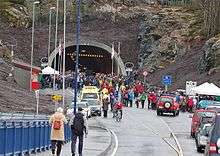Eiksund Tunnel
 Opening ceremony, 23 February 2008 | |
| Overview | |
|---|---|
| Location | Møre og Romsdal, Norway |
| Coordinates | 62°13′06″N 5°59′10″E / 62.2182°N 5.9862°ECoordinates: 62°13′06″N 5°59′10″E / 62.2182°N 5.9862°E |
| Route | 653 |
| Operation | |
| Opened | 23 February 2008 |
| Operator | Statens vegvesen |
| Traffic | Automotive |
| Character | Passenger |
| Vehicles per day | 2884 |
| Technical | |
| Length | 7,765 m (25,476 ft) |
| No. of lanes | 3 |
| Lowest elevation | −287 m (−942 ft) |
| Width | 10 m (33 ft) |
| Grade | Maximum: 9.6% |
The Eiksund tunnel (Norwegian: Eiksundtunnelen) is an undersea tunnel in Møre og Romsdal county, Norway, which runs under the Vartdalsfjorden connecting Ørsta Municipality and Ulstein Municipality. The tunnel is 7,765 metres (25,476 ft) long and reaches a depth of −287 metres (−942 ft), which makes it the deepest undersea tunnel of its kind in the world.
Localities served
The tunnel was built as part of a large project including 3 tunnels and a bridge connecting several islands to the mainland. The bridge–tunnel complex serves the municipalities of Herøy, Sande, Ulstein, Hareid, Ørsta, and Volda, which together have over 40,000 inhabitants. The Eiksund Bridge joins Hareidlandet island and the village of Eiksund with the nearby island of Eika. The Eiksund Tunnel begins at the south end of the bridge (on Eika island) goes under the Vartdalsfjorden and connects to the mainland near the village of Ørsta.
These three structures are a part of Norwegian County Road 653, a highway that links Norwegian County Road 61 between Ulstein and Herøy to the European route E39 highway between Ørsta and Volda.[1]

Construction
The 405-metre (1,329 ft) long Eiksund Bridge and the 1,160-metre (3,810 ft) long Helgehorn Tunnel were built along with the tunnel. The total cost of the tunnel was about 800,000,000 kr. The tunnel was originally intended to be opened to the public in July 2007,[2] but numerous delays pushed the date back to December 2007 and then eventually to 2008. The tunnel was opened to traffic on 23 February 2008.
The Eiksund Tunnel is an undersea rock tunnel created by drilling and blasting, with 1,300 tonnes of explosive used. 660,000 cubic metres of rock were removed during construction.[3]
Usage
The tunnel carries three lanes of traffic, allowing for a crawler lane on each exit gradient. Prior to construction the average daily traffic through the Eiksund Tunnel was projected to be 1,000 vehicles per day (vpd). The ease of crossing the fjord, however, rapidly increased traffic to 2200 vpd. When the tunnel was fully financed after six years and became toll free, traffic jumped again to 2880 vpd.[4]
Incidents
On 28 June 2009, there was a severe accident in the tunnel, leaving five men dead. A young driver with three male passengers in their 20s was thought to have been driving at around 150-200 km/h (90-120 mph) hit the side of the tunnel and flipped his car which struck an oncoming vehicle carrying only its driver.[5]
See also
- Extreme points of Earth
- Rogaland Fixed Link, a deeper Norwegian undersea tunnel under construction since 2015
References
- ↑ Store norske leksikon. "Eiksundtunnelen" (in Norwegian). Retrieved 21 September 2010.
- ↑ "Norwegian Public Roads Administration". Statens Vegvesen. Retrieved 6 January 2017.
- ↑ "Eiksund Undersea Tunnel, Norway". Kable Intelligence Limited. Retrieved 6 January 2017.
- ↑ "Bomstopp gav trafikkhopp" (in Norwegian). Sunnmørsposten. 15 July 2014.
- ↑ "Dødsulykke i Eiksundtunnelen" (in Norwegian). Dagbladet. 28 June 2009. Retrieved 15 February 2010.